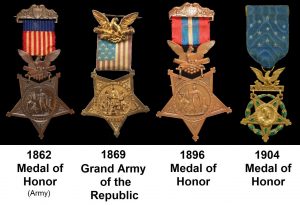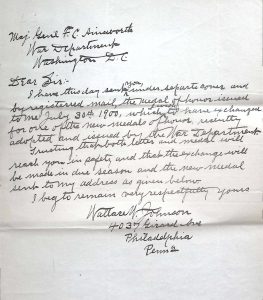The National Archives (NARA) holds a file for each recipient of the Medal of Honor. The file typically contains the soldier’s original nomination, testimonials of witnesses, correspondence with the veteran, and other related documents. We scanned the contents of such a file yesterday and it contained some fascinating details.
But first a little history of the Medal of Honor…
On 21 Dec 1861, President Lincoln signed legislation establishing the Medal of Honor. The first medals were awarded in 1863.
In 1869, the Grand Army of the Republic (GAR) announced its membership badge which was available to any member of that veteran organization in good standing. In the coming years, the GAR badge was worn by more than 400,000 veterans. The badge was – let’s just say – suspiciously similar to the Medal of Honor. Even today, the GAR membership badge is very commonly mistaken for a Medal of Honor.
The similarity to the GAR badge (as shown in the image above) led to the formation in 1890 of the Medal of Honor Legion (now the “Legion of Valor”) which had the mission to protect the integrity of that medal and prevent its devaluation by impostors. To that end, in 1896 a more distinctive ribbon was designed for the Medal of Honor and in 1904 the medal was redesigned altogether and protected by a patent.
Enter our hero of this story: Sgt. Wallace W. Johnson of the 6th Regiment Pennsylvania Reserve Infantry (aka 35th PA Volunteers) whose Medal of Honor file we copied at the National Archives.
Sgt. Johnson was awarded his Medal of Honor for his actions at the Battle of Gettysburg. His citation reads, “With five other volunteers gallantly charged on a number of the enemy’s sharpshooters concealed in a log house, captured them, and brought them into the Union lines.” His Medal of Honor file includes a testimonial from an officer in his company and several others from eyewitnesses to the event in question.
Although the action for which he was honored occurred on 2 Jul 1863, Sgt Johnson was not awarded the medal until 37 years later: on 30 Jul 1900. He therefore received the 1896 version of the medal pictured above.
Upon release of the 1904 design of the Medal of Honor, recipients of the earlier medal were encouraged to return it in exchange for one of the new design. Sgt. Johnson dutifully returned his medal to the War Department. He also sent this letter asking that “the exchange will be made in due season and the new medal sent to my address” in Philadelphia.
His file at the National Archives reflects the War Department’s record that Sgt. Johnson’s medal and letter were received on 9 Aug 1905 and the new one was issued to him about a month later.
The War Department discovered, however, that many other recipients were unwilling to part with their original medal for sentimental reasons. Consequently, on 27 Feb 1907, Congress authorized that the new medal would be sent to any previous recipient who requested it without requiring that they return the original. The only stipulation was that the recipient was not permitted to wear both medals at the same time.
But it was too late for Sgt. Johnson who had already returned his original medal. So on 23 Mar 1907, Sgt. Johnson sent another letter to the War Department, this time requesting that his original medal be returned to him. This letter too is preserved in his file at the National Archives.
His request was granted.

Sgt. Johnson died just three and a half years later on 30 Dec 1911. Upon his death, both of his medals found their way back to the battlefield on which they had been earned. They are held today in the museum collection at Gettysburg National Military Park.
Further reading:
- Congressional Medal of Honor Society
- Fun Facts about the Medal of Honor
- One of our FaceBook pages: Gettysburg Medals and Badges
Copyright (c) 2024, Gopher Records, LLC.




